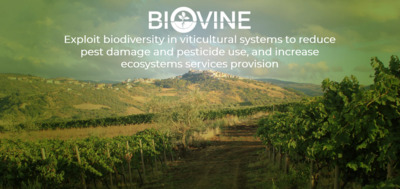{Tool} Increase plant health through mycorrhizal fungi (BIOVINE Practice Abstract). Creator(s): Noceto, Pierre Antoine; Courty, Pierre-Emmanuel and Wipf, Daniel. Issuing Organisation(s): INRAE - National Research Institute for Agriculture, Food and Environment. CORE Organic Practice Abstracts. (2020)
|
PDF
- Published Version
- English
(Increase plant health through mycorrhizal fungi)
259kB | |
![[thumbnail of BioVine_2.png]](/39936/2.hassmallThumbnailVersion/BioVine_2.png)  Preview |
Image (PNG)
- Cover Image
- English
2MB |
Summary in the original language of the document
This BioVine Practice Abstract shows how mycorrhizal fungi can be leveraged to increase plant health, providing practical recommendations for cover cropping. Once well established, cover cropping might drive winegrowers to reduce the use of pesticides and fungicides, while also increasing the ecosystem services provided by both plants (e.g., reservoir of biodiversity, bee-forage plants) and mycorrhizal fungi (e.g., nutrition, protection).
| EPrint Type: | Practice tool |
|---|---|
| Teaser: | This BioVine Practice Abstract shows how mycorrhizal fungi can be leveraged to increase plant health, providing practical recommendations for cover cropping. |
| What problem does the tool address?: | Different types of pests and abiotic stress factors (e.g., deficiency of nutrients, drought) reduce the quantity and quality of agricultural and horticultural crops worldwide. Arbuscular mycorrhizal fungi (AMF) are obligate symbionts of a large majority of land plants that provide multiple ecosystem services. The symbiotic interaction of AMF with grapevine roots improves plant development, fitness, health, and fruit quality by improving access to nutrients and water as well as soil structure and tolerance to abiotic stresses and soil-borne pathogens or root diseases. Mycorrhizal symbiosis is a beneficial symbiosis where nutrients are exchanged between the two partners (sugars from plants to AMF; water and micronutrients from AMF to plants). In viticulture, practices such as soil management and the use of fertilisers, herbicides, and pesticides alter microbial diversity and AMF community composition as well as the ecosystem services they provide. |
| What solution does the tool offer?: | Grapevine is a woody perennial crop with a winter dormancy after leaves drop. The rise of plant diversity, winter soil-covering vegetation, and the strong reduction of tillage positively impact ecosystem services provided by AMF by increasing their abundance and richness while maintaining the integrity of the common mycelial network. Winegrowers can make use of different types of cover crops and mixtures for a permanent cover rich in weeds and adapted to the vineyard. However, they cannot control weed species that could compete with grapevine for water and nutrients. Winegrowers might also try various cover plants (e.g., single plants species like cheatgrass or a mixture of Poaceae and Fabaceae) in association with grapevine. Fabaceae form mycorrhizal and rhizobial symbiosis. These plants fix atmospheric nitrogen, which is then transformed to ammonia, a nitrogen source that is either returned to the soil after cutting down the plant or given to the grapevine plant through the common mycorrhizal networks linking plant roots. However, it should be considered that some plants do not or only slightly form arbuscular mycorrhizal symbiosis. This is true for the following plant families: Brassicaceae (e.g., mustard, cabbage, horseradish), Chenopodiaceae (e.g., redroot pigweed), Boraginaceae (e.g., forget-me-not, bell, or borage), Caryophyllaceae (e.g., cowbell, clove pink, red campion), Polygonaceae (e.g., sorrel), Resedaceae (e.g., wild mignonette), Scrophulariaceae (e.g., false pimpernel). Cover crops can moreover be used as a repellent for parasitic organisms that are harmful to the vine. The chemical composition of root exudates can modify and even inhibit (e.g., Brassicaceae) the growth of arbuscular mycorrhizal communities. |
| Country: | France |
| Type of Practice Tool: | Practice abstracts |
| Theme: | Soil quality and fertility, Nutrient management, Pest and disease control, Weed management, Crop specific |
| Keywords: | Cover cropping, viticulture, arbuscular mycorrhiza, plant health |
| Agrovoc keywords: | Language Value URI English plant protection http://aims.fao.org/aos/agrovoc/c_5978 English grapevines http://aims.fao.org/aos/agrovoc/c_3360 English cover plants http://aims.fao.org/aos/agrovoc/c_1936 English cropping systems http://aims.fao.org/aos/agrovoc/c_1971 English Arbuscular mycorrhiza http://aims.fao.org/aos/agrovoc/c_1415699873241 English viticulture http://aims.fao.org/aos/agrovoc/c_8277 English sowing http://aims.fao.org/aos/agrovoc/c_7268 English mulching http://aims.fao.org/aos/agrovoc/c_4978 English plant disease control http://aims.fao.org/aos/agrovoc/c_5960 English pest control http://aims.fao.org/aos/agrovoc/c_5726 English organic agriculture http://aims.fao.org/aos/agrovoc/c_15911 |
| Subjects: | Crop husbandry > Crop combinations and interactions Soil Crop husbandry > Greenhouses and coverings Environmental aspects > Biodiversity and ecosystem services Crop husbandry > Crop health, quality, protection Crop husbandry > Production systems > Fruit and berries > Viticulture |
| Research affiliation: | European Union > CORE Organic > CORE Organic Cofund > BioVine France > INRAe - Institut national de recherche pour l’agriculture, l’alimentation et l’environnement European Union > Organic Farm Knowledge |
| Related Links: | https://www.biovine.eu/, https://organic-farmknowledge.org/de/tool/39936 |
| Project ID: | ofk |
| Deposited By: | Gernert, Maria |
| ID Code: | 39936 |
| Deposited On: | 19 May 2021 08:35 |
| Last Modified: | 02 May 2024 10:32 |
| Document Language: | English |
| Status: | Published |
Repository Staff Only: item control page

 Download Statistics
Download Statistics Download Statistics
Download Statistics
